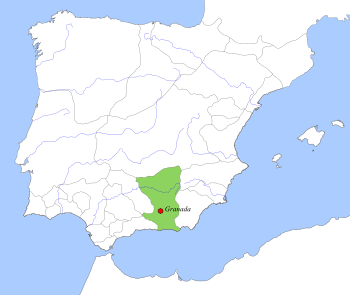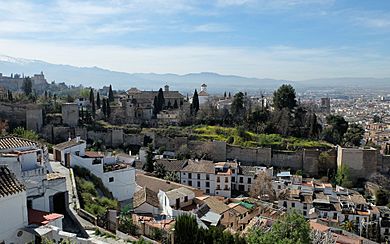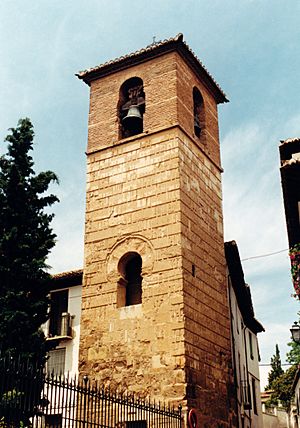Taifa of Granada facts for kids
Quick facts for kids
Taifa Kingdom of Granada
طائفة غرناطة
|
|||||||||
|---|---|---|---|---|---|---|---|---|---|
| 1013–1090 | |||||||||

Taifa Kingdom of Granada, c. 1037.
|
|||||||||
| Capital | Granada | ||||||||
| Common languages | Arabic, Berber, Mozarabic, Hebrew | ||||||||
| Religion | Islam, Christianity, Judaism | ||||||||
| Government | Emirate | ||||||||
| Malik (King) | |||||||||
|
• 1013–1019/20
|
Zawi ibn Ziri | ||||||||
|
• 1019/20–1038
|
Habbus al-Muzaffar | ||||||||
|
• 1038–1073
|
Badis ben Habus | ||||||||
| Historical era | Middle Ages | ||||||||
|
• Move of the Zirids to Granada
|
1013 | ||||||||
|
• Annexation by the Almoravids
|
1090 | ||||||||
| Currency | Dirham and Dinar | ||||||||
|
|||||||||
The Taifa of Granada (Arabic: طائفة غرناطة, Ta'ifat Gharnata, Spanish: Taifa de Granada) was a Muslim kingdom in al-Andalus (what is now southern Spain). It was founded in 1013 by a Berber group called the Zirid dynasty. This happened after the powerful Caliphate of Cordoba started to break apart.
The kingdom's main city was Granada, which became its capital. For a while, it also controlled Málaga. Four kings from the Zirid family ruled this kingdom for nearly 80 years. The Taifa of Granada was known as one of the richest of all the Taifa kingdoms. In 1090, it was taken over by the Almoravids, ending the Zirid rule in Granada.
Contents
History of the Granada Kingdom
How the Zirid Kingdom Started
The Zirids were a Berber clan from North Africa, specifically from a region called the central Maghreb (modern-day Algeria). They worked for the Fatimid Caliphate and later ruled parts of North Africa for them. The Zirid family was started by Ziri ibn Manad.
Around 999, some of Ziri's relatives, including Zawi ibn Ziri, rebelled. They were defeated, but Zawi survived. He led his followers west to al-Andalus (Islamic Spain). There, they joined the army of the Umayyad Caliphs of Cordoba.
The Caliphate of Cordoba began to fall apart after 1008. This period is known as the fitna. Zawi and other Berber groups helped in the siege of Cordoba from 1010 to 1013. After the siege, they helped put their own chosen caliph in charge.
By 1013, Zawi and his group realized that Cordoba's power was ending. They looked for new opportunities. The new caliph gave Zawi and his followers the province of Ilbira (near modern-day Granada) to live in. The local people of Ilbira had asked the Zirids to settle there for protection.
Soon after, Zawi moved his capital from the old city of Ilbira to a more protected place nearby called Granada (Gharnāṭa). Granada was a small town before this. Zawi's move led to the creation of a new city and an independent kingdom that lasted for 77 years.
In 1018, an army tried to attack Granada, but the Zirids won. However, in 1019 or 1020, Zawi left al-Andalus and went back to North Africa. His exact fate is not known for sure.
Growth and Golden Age of Granada

In Granada, Zawi's nephew, Habbus ibn Maksan, was asked to become the new ruler. Under Habbus (1019–1038), the Taifa of Granada became stronger. It grew into one of the most important kingdoms in al-Andalus. Habbus organized the army and built the Zirid fortress in Granada, located in what is now the Albaicín area.
Habbus expanded his territory by taking over Cabra and Jaen around 1028–1029. He also gained influence over the Taifa of Almeria to the east. Granada's main rival was the Taifa of Seville. At first, Granada was stronger. In 1036, Habbus led an army that attacked Seville, burning parts of the city. By the end of his rule, Habbus had secured a kingdom that included Ilbira, Jaen, and Cabra.
Habbus's son, Badis Ibn Habbus, became king in 1038 and ruled until 1073. His rule started with some family disagreements. However, Badis managed to stop a plot against him. The ruler of Almeria tried to take advantage of these problems by attacking Granada. But Granada's army defeated him, and Almeria became a state controlled by Granada for several years.
In 1039, the Zirids also defeated the Abbadids of Seville in a battle. They gained some land to the west. Badis also took over Málaga in 1056 and made his son, Buluggin Sayf ad-Dawla, its governor. Badis's rule was the peak of Granada's power and wealth.
During the reigns of Habbus and Badis, a Jewish leader named Isma'il ibn Nagrilla (also known as Samuel ha-Nagid) became very powerful. Isma'il was a smart and educated man who had fled Cordoba. Habbus made him his secretary in 1020 and gave him important jobs, like collecting taxes. He became Badis's most trusted advisor and even led the army.
After Isma'il died in 1056, his son Yusuf took his place. But Yusuf was not as skilled as his father. He made many enemies. When Badis's older son, Buluggin, died, Yusuf was suspected of poisoning him. In 1066, Yusuf secretly invited the ruler of Almeria to take over Granada. But the plan failed. When Yusuf's plot was discovered, it led to a violent reaction. Yusuf and his allies were killed, and there was a terrible event called the 1066 Granada massacre, where many Jewish people in the city were attacked.
Decline and Fall of the Kingdom
After these events, the kingdom of Granada became weaker. It also had many wars with the Taifa of Seville and other neighbors. When Badis died in 1073, his grandson, 'Abdallah ibn Buluggin, became king. He was only about 7 to 9 years old. A regent named Simaja was appointed to help the young king.
Around this time, the Taifa kingdoms, including Granada, started to rely on Christian kings from northern Spain for military help. Especially King Alfonso VI of Castile and León. Alfonso's plan was to make Seville and Granada fight each other. This would weaken them both. He also made them pay him parias (a type of tax or tribute).
The Zirids lost the Battle of Cabra in 1079 against Seville's forces. Both sides had Castilian knights helping them. The constant wars also meant higher taxes, which made people unhappy. There were often rebellions.
The kingdom's problems got worse in the 1080s. Alfonso's armies started moving into al-Andalus. At the same time, the Berber Almoravids from North Africa began to get involved in Spain. In 1089, 'Abdallah was forced to help the Almoravids in a siege that failed. After this, he tried to keep good relations with both Alfonso VI and the Almoravids.
Finally, the Almoravids captured Granada in September 1090. This ended the independent kingdom. 'Abdallah knew the Almoravids were too strong. He surrendered the city without a fight. The Almoravids took him prisoner and took all his property. But he was allowed to live in exile in Aghmat (in modern-day Morocco). There, he wrote a book about his rule and his family. This book has given historians a lot of information about this time.
Society and Government in Zirid Granada
Under Zirid rule, Granada had a very mixed population. There were three main groups: the Andalusi Arabs, the Jewish community, and the Sanhaja Berbers. Other groups were also present, like Muslims of Iberian descent and people from other North African tribes. There were also enslaved people. Many people moved to Granada from Cordoba during the fitna to escape the fighting. There were also Christians in the city, but they disappeared by the 12th century.
Granada became an important Islamic city under the Zirids. Islamic learning and scholars started to develop there. Most of the Islamic scholars were of Arab origin. This suggests that Islamic knowledge was often linked to Arab identity.
The Zirid state in Granada kept many Berber traditions. For example, a jamā'a, or tribal meeting, chose the next ruler from the Zirid family. This group also ruled alongside the king. The language spoken in the court was a Berber language, and people spoke it in daily life too. Women, especially those from the ruling families, also played a somewhat important role in politics.
The Role of Jewish People
The Zirid Taifa period was a very important time for Jewish leaders in Granada and for Jewish people in al-Andalus in general. It was a golden age for Jewish culture and politics. Under the Zirid kings, a Jewish man named Samuel ha-Nagid (Isma'il ibn Nagrilla) even commanded the army. This was very unusual at the time. Some historians describe the Zirid state during this period as almost a "Jewish kingdom" because of the power Jewish leaders had. The power and status of the Jewish community in Granada were unique in the entire Islamic world.
The Banu Naghrela family (Samuel ha-Nagid's family) reached the highest positions in the kingdom's government. Another Jewish family, the Banū 'Ezra, supported arts and sciences. The Jewish community in Granada was also connected to Lucena, an important center for Jewish law studies. Samuel also kept in touch with Jewish communities across the Muslim world. He sent gifts and supported scholars.
However, challenges remained for Jewish people as a minority group. The Zirid kings chose Jewish leaders like Samuel because they preferred to give power to a Jewish aristocrat rather than an Andalusi Arab. An Arab leader might have had loyalties to other Muslim groups. As a non-Muslim, Samuel could not officially become king in a Muslim state. This made him a good choice for the powerful position of vizier (a high-ranking minister).
The Jewish community was led by older leaders, and sometimes there were rivalries among them. For example, when Habbus ibn Maksan died in 1038, Samuel supported Badis becoming king. But another powerful Jewish leader supported Badis's brother. When Badis's brother died, the Jewish leaders who supported him fled. This left Samuel as the main leader of the Jewish community in Granada. The massacre of 1066 and the later arrival of the Almoravids led to the decline of the Jewish community in Granada.
Zirid Architecture
The buildings of the Taifa kingdoms, including those of the Zirids, continued the styles from the Caliphate of Cordoba. But they also added new ideas. Zirid architecture in al-Andalus was influenced by Cordoba and also by the Hammadid buildings in North Africa. Several buildings in southern Spain today are thought to be from the Zirid period.
In Granada, the Bañuelo (a public bath complex) is traditionally believed to be from the 11th century, during the Zirid rule. (Though some newer studies suggest it might be from later.)
The original Zirid palace and fortress, called the al-Qasaba al-Qadima, was on the hill where the Albaicín neighborhood is now. This building is no longer standing. However, the inner northern walls of the city, which run along the top of the Albaicín, are still from this time. The Alcazaba of Granada, a fortress on the Sabika hill, was first built by the Zirids. It was later rebuilt and became part of the Alhambra of the Nasrids. But parts of the original Zirid fortress remain.
The Zirids are also thought to have built the Great Mosque of Granada. The site of this mosque is now where the Cathedral stands. In the Albaicín, the bell tower of the Church of San José was originally a minaret (a tower for calling to prayer). It is traditionally dated to the Zirid period. It belonged to a mosque called the al-Murābiṭīn Mosque.
Outside Granada, the Alcazaba of Malaga was also built during the Taifa period in the 11th century. It was later changed by the Nasrids. The parts that remain from the 11th century were likely built by both the Zirids and the Hammudids.
List of Rulers
The four Zirid kings of Granada were:
- Zawi ibn Ziri: 1013–1019
- Habbus ibn Maksan al-Muzaffar: 1019–1038, nephew of Zawi
- Badis ibn Habbus: 1038–1073, son of Habbus
- Abdallah ibn Buluggin: 1073–1090, grandson of Badis
See also
 In Spanish: Taifa de Granada para niños
In Spanish: Taifa de Granada para niños
- Emirate of Granada
- History of Islam
- History of Spain
- List of Sunni Muslim dynasties


